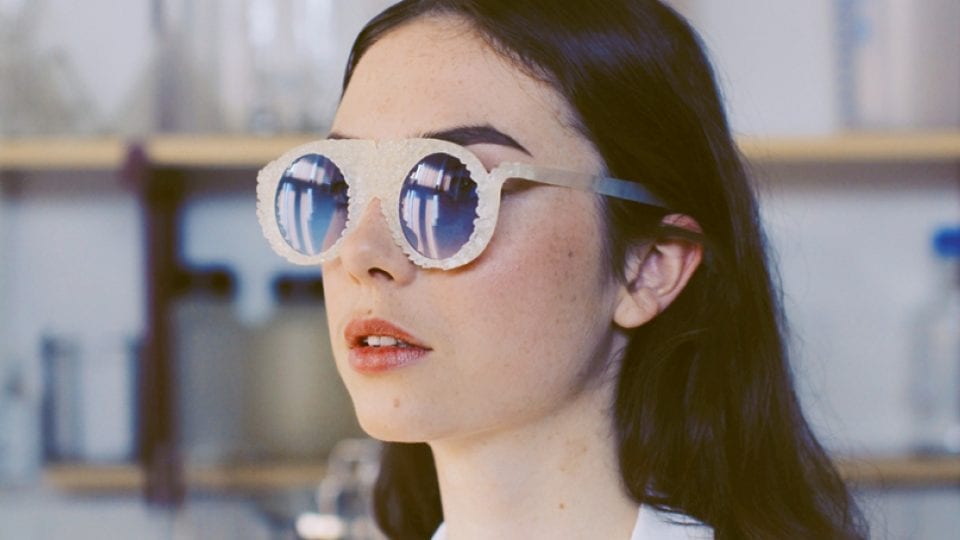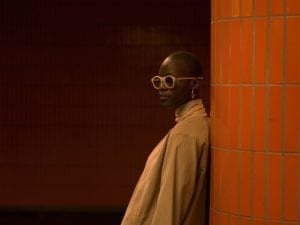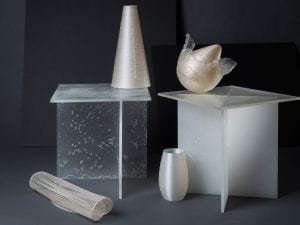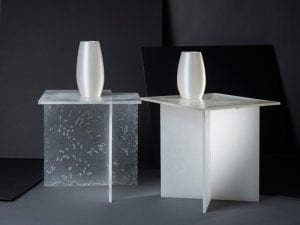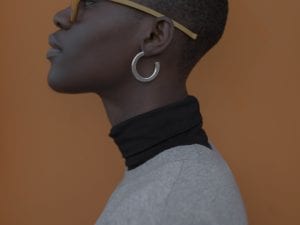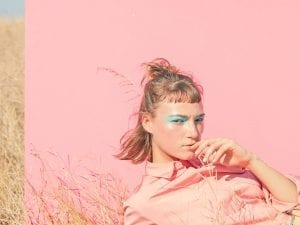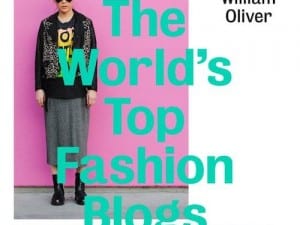A Berlin-based studio brings bioplastic into the fashion industry at large by experimenting with plant-based processes to address the global issue of waste.
Established in 2015, crafting plastics! studio began as a non-formal collective of designers, working from a base in Berlin. Since then, their striking, sustainable practice has gone from strength to strength, and has been featured in a wide number of publications as well as being recognised through gaining a number of prestigious awards. The premise is disarmingly simple: to challenge the environmental problems which are created by a culture of so-called fast-fashion by making items that are purposely made to biodegrade over time. In so doing, the group has produced two collections of eyewear, and is currently looking towards interior design.
The complexity of the work and the level of care that goes into every stage is stunning. Conceptualising the company’s “core value” as research, it not only focuses upon product design but also material development. Mária Kadlecová, Operations Manager, describes how the team spent years developing a plant-based plastic. “After three years of optimisation, we finally reached the mixture that can be 3D printed, injection moulded and pressed. This opened up a new direction for us.” The studio is currently in the process of registering for a trademark for the bioplastic, which will help “to make wider impact in the future, by offering the material to other companies and creators.”
The recognition that this approach has received makes it clear that it’s a viable and attractive option: the company has been awarded accolades from, amongst others, Prague Designblok (crafting plastics!’s first prize, and one they say they will always remember) and the Slovak National Design Award, in the Design with Added Value category. Yet the most valuable interactions, they say, come from discussions with people who do not have prior knowledge of their practice and its possibilities: “It is so fruitful to get out of our bubble and meet reality. It is frequently the case that people have partial information, but there are so many misunderstandings as well as prejudices.”
Changing perceptions, then, is a big issue. Disposability is the most overt problem in design and indeed the wider world. It is a negative consequence of mass production, demonstrated by the level of waste produced today. However, by making products that have a defined and considered lifespan, crafting plastics! challenges this narrative. “The new generation of bioplastic decomposes as industrial compost,” Kadlecová explains. She acknowledges that whilst recycling is important, it is not a long-term solution. In fact, their first eyewear collection almost mocks fast-fashion: “You buy [the item] in faith to use it forever, but in reality, you will buy a new one … You lose it, break it, buy another.” In other words, its disposable nature becomes a central, and vital, design feature.
This notion has become a major goal for the studio: changing the way that people interact with objects and materials. “We are consciously trying to create the potential of a new relationship between the consumer and ecological plastic, not just by choosing the right product but also by enabling buyers to understand how it is made.” The collective wants to “show the process, allow customers to be part of the research.” As they do so, they also hope to change the prevalent opinion that green materials can only be used for packaging materials and single-use products: “The new line of 100 per cent bioplastic is strong and durable. The eyewear collection was just a start, and the new bigger pieces, such as furniture, are already in progress. By offering durable products, we are combatting a lot of myths: for example, we want to prove to people that our material will not start to fall apart when it is raining.”
In fact, by making design-driven objects intended for wear, crafting plastics! also makes a crucial point that scientific research into materials is not just for “useful” items. People ask, “why don’t you make something like single-use cutlery?” But, Kadlecová says, “it’s difficult to understand. What people don’t know is that ecological plastic will probably not be able to compete with the synthetic plastic price for at least the next year or two. And with the single-use products, it will always be about the cheapest possible options. We don’t have that choice yet.” She hopes that by coming up with durable, beautiful pieces, the company will play a role in encouraging further demand for ecological products. In turn, factories may begin to see the value in creating these on a larger scale. It’s still a new and developing area, and she observes that “it needs more creatives to get involved to inspire bigger change within public and professional perceptions.”
A growing contemporary interest in artisanal craft undoubtedly forms part of the broader context in which crafting plastics! works. In fact, there is a certain handmade ethos which underpins their work even from the early days. “At the time we started, we did not have the machines for processing plastic,” Kadlecová says. “So we tried to process its raw form using the tools we had around us. We let the material speak for itself. It is very malleable, and the low melting temperature gave us a variety of options.” They were also impressed by what they call the prototype’s “unusual aesthetic”, something which is evident in the finished products as well as in the manufacturing process. Subverting common ideas about plastic, she says, “it is also non-toxic: even when it is melting it smells like baking bread and you can handle it with your bare hands.”
Visual appeal is, of course, extremely important for the studio’s output. It seems clear that interest is growing in sustainable fashion but despite improving over the last few years: “This scene is still not appealing and seductive enough for the consumer.” Pointing to the widespread use of apparently natural colours such as green and brown, the group describe how “many creators feel this is the only way to sell ecological fashion products. They are afraid that using new colours and structure will make customers think that the products are made from synthetic materials. But in reality, the ‘boring’ natural appeal of this colour scheme can be discouraging for high fashion clients.”
Instead, the team presents striking ranges that will not simply disintegrate: “They are strong and durable,” Kadlecová says, despite a short life span. They do not dissolve when in contact with skin or water, and would need to be placed in specific conditions (a moist environment with a constant temperature in excess of 50 degrees Celsius for a period of 90 days or more) before beginning to biodegrade.
Being part of the process at every stage allows the collective to understand their products on a microcosmic level. “As well as developing the plastic themselves,” Kadlecová explains, “they are the testers of our designs – we wear and try out the products, then give them to our friends. We have pieces of bioplastic in our homes – watching the material grow old in real time and in domestic spaces – as opposed to laboratory simulations.” Knowing an object and its properties so well offers the team “a lot of freedom, because we can be innovative at the earliest stage of an object’s existence – even before it is born. It also gives us a lot of potential for idea generation and production, which can sometimes be overwhelming.”
This open-ended energy is channelled succinctly into the production of beautiful and sculptural pieces. The work has evolved since the team’s first collection, which was hand-crafted, and has now moved towards the use of technology and filament 3D printing. As such, the delicate frames fulfil their potential as scientific experiments, whilst responding to contemporary fashion trends. The team has also begun to play around with colours: “For our second collection, the products are available in Orange Seaweed, Bohemian Green, Mysterious Blue.” There is a fourth option: Nude. In the process of creating the new line, the colour of the material evolved into an ivory shade that resembled a pale skin tone. Whilst the frames are biodegradable, lenses are made from mineral glass: there is currently no “bio-based” alternative on the market, but this is at least recyclable.
Looking ahead, Kadlecová and the team hope to move towards “more accessible items in terms of price and daily use. We want to have functional objects.” This means a shift in focus to interior design and furniture. “We hope it will become more and more commonplace when choosing a new product to ask and get complete information about its origins, toxicity and carbon footprint.” In other words, sustainability is not just a priority in ready-to-wear fashion – it extends to wider consciousness. “People are slowly starting to embrace the idea of choice, and with that comes power: producers and manufacturers will follow demand. Customers can either buy a disposable product that will stay in landfill for hundreds of years, or, for a similar price, they could buy something that after use, ceases to exist entirely and leaves no measurable trace on the planet.”
Having recently launched a studio for inclusive practices, the company believes that collaboration is important in achieving their end-goal of sustainability and transparent production. “It is the principle we cherish the most … We would not be able to accomplish so much if we were just on our own. It brings necessary value into our projects, as well as being fun. Together we can do a lot and also teach each other even more.” Working closely with scientists, for example, is informative for both parties: “We see multidisciplinary approach as key to solving complicated issues.” Moreover, by engaging in discussions and collaborating with others, they hope to influence greater changes: “This research is not purely for ourselves. By telling our story, we hope we can inspire others.”
With their innovative methods and bright, engaging aesthetic, it is no surprise that crafting plastics! is currently working on a number of notable collaborations. The collective hopes to continue the journey into the ecological plastics industry, bringing their knowledge to a wider audience in the commercial marketplace. Additionally, the studio is attempting to develop a substance that would be suitable for home composting, whilst retaining a focus on fashion and product design. As a group, they are not afraid “to dream big” as Kadlecová enthuses – and their continued, growing success is testament to this optimistic mantra.
Words
Anna Feintuck


